#insect identification guide
Photo
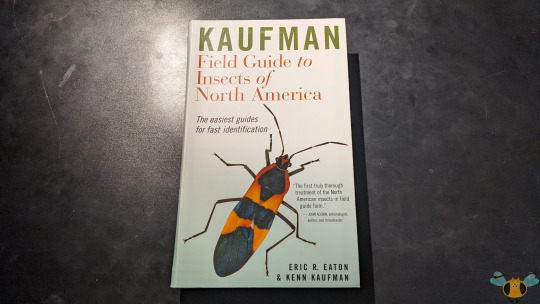
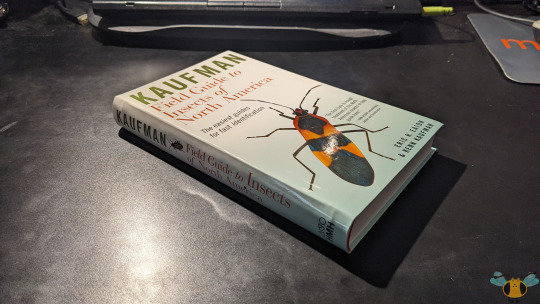
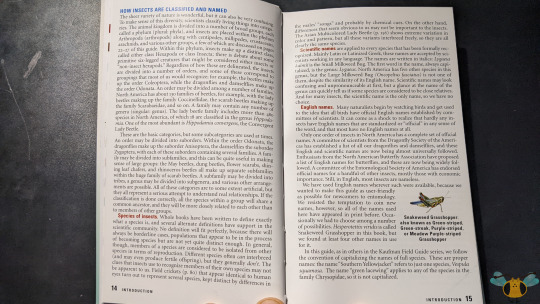
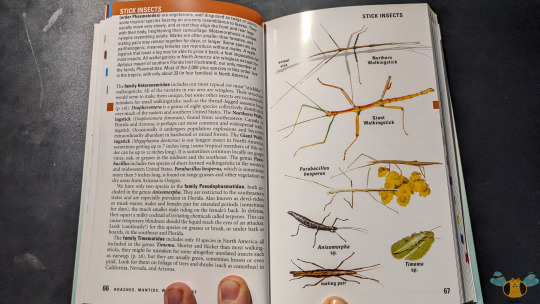


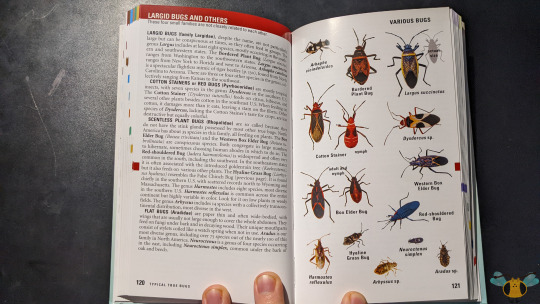
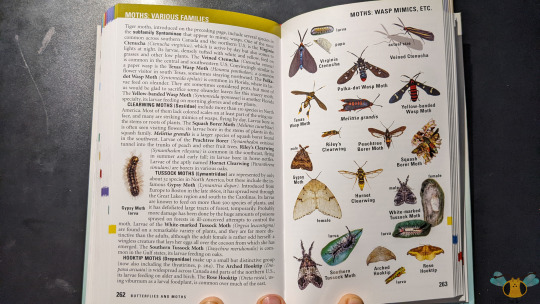


Kaufman Field Guide to Insects of North America, by Eric R. Eaton and Kenn Kaufman
I’ve added a new field guide to my growing collection of insect identification resources. This book was recommended to me after I picked up the Audubon Butterfly guide, and I have to say, I quite enjoy this book and it will be accompanying me on outdoor daylong bug hunts alongside the Audubon books. If you’re looking for something a bit more general, perhaps as an entry resource to help you catalogue and identify insects as a hobby, this book is a great starting point. The format of the book is mostly consistent with Pictures 4-8: key information on the left side of the book and pictures of insects on the right. The information is simple to understand and very articulate, highlighting crucial information that can help you sort insects into their different orders and families. For example, in the Beetle section, there are separate pages that would highlight the key characteristics that make each insect special which in turn allows a simple identification for each Beetle such as what makes a Leaf Beetle and a Longhorn Beetle. Many prominent species are highlighted in the field guide, but mostly those living in Canada and the USA. Of course, the guide can’t cover every insect specie, but the descriptions given are to the point you may recognize some of the more common species included. For something more technical, you many have to turn to another guide or consult an internet resource.
The insect imagery in the book is quite good, really aiding the text descriptions. I give many thanks to the contributing photographers of this guide and I wish that there were sections that would showcase larger insect pictures and diagrams. It would definitely help with the author’s goal of “naked eye identification” and to highlight some of the more rare insects, insects that look similar to other insects, and insects that (while presumed common) aren’t part of common knowledge. It’s for this reason that I highlight Picture 6 which documents Mantidflies (Mantispids). These are not Mantids or Flies and they can resemble Wasps, but they are in fact Neuropterans! It’s not something everyone would know and thus I think it should receive a bit more attention. A little bit of information can make the difference between knowing which insects to avoid and which look fearsome but are harmless, just like the Mantidflies. As well, finally a visualization of Snakeflies on this blog! Finally, what I enjoyed most about this field guide was the passion and love for insects on display in the writing. The people who wrote and contributed to this book clearly love these creatures and want to share with others why insects are important, what we can learn from them and how they impact Earth and our lives. All this is presented in a way that (aside from a few scientific or technical terms) is easily digestible and readily applicable.
To all those looking to create a hobby based on insects, learn the basics of insect identification or if you have a real passion for insects, I do recommend this book. I’ll be using it where I can, and until then it will stay with the other books I reference lined up on the bookshelf. To conclude, there are sections in the book on Arachnids and non-insect hexapods which I also appreciate, if only to highlight the difference between them and insects.
For additional insect literature, you may visit the Blog Resources page.
#jonny’s insect catalogue#insect field guide#kaufman field guide to insects of north america#field guide to insects of north america#north america insect guide#field guide#insect identification guide#amateur insect guide#insect pictures#insect facts#insect identification#entomology#invertebrates#arthropods
6 notes
·
View notes
Text
one of the bee experts has left a giant paragraph of words I do not understand on the observation for the other bee experts
ooh and a link to a free guide for learning to identify bumblebees for beginners!!
"https://www.xerces.org/publications/identification-and-monitoring-guides/bumble-bees-of-eastern-united-states"
(Archived link)
O:
#Rjalker does iNaturalist#bumblebees#bumblebee identification#bees#insects#bugs#insect identification#identification guides#free books#it counts!!!!!!!!!!!!!!!!!!!!!!!!!!!!!!!!!!!!!!!!!!!!!!!
1 note
·
View note
Text
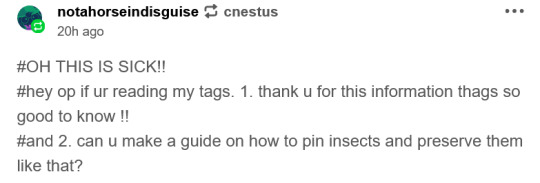
(tagged on this post)
@notahorseindisguise sure, just like a general guide on insect pinning? i can do that.
the nice thing about insects is that once they dry they'll stay exactly as they were positioned indefinitely, so the trick is to pin them when they're still pliable. if you're trying to pin an old, dried insect, you can rehydrate them by putting them in an airtight container with some wet paper towels or sponges for 12-24 hours but probably not much longer than that or you'll risk them molding. i spray some ethanol in there too to be safe. as an example, here's my rehydration box with some bee samples:
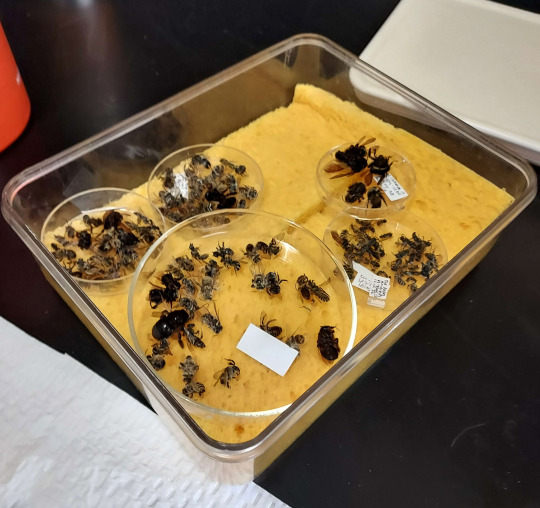
once your insect is ready to curate, put the pin through the thorax to the right of the midline like in my previous post. now, i'm of the philosophy that if you're pinning an insect, you ought to curate it as best as you can so that its death wasn't in vain, so while the specimen is still pliable, secure it to a thick piece of foam and use more pins to position all the legs and antennae into as pleasing an arrangement as possible. here's a botfly i arranged:


besides the aesthetic reasons, this will also help with future identification if that's a possibility since often insects die curled up with important diagnostic features covered up or otherwise hard to see, so at least unfurling the legs a bit and making sure the wing venation is visible on insects where that's important is a good idea.
sometimes you get a longhorned beetle with very long antennae. this is why you want to have a lot of pins on hand:
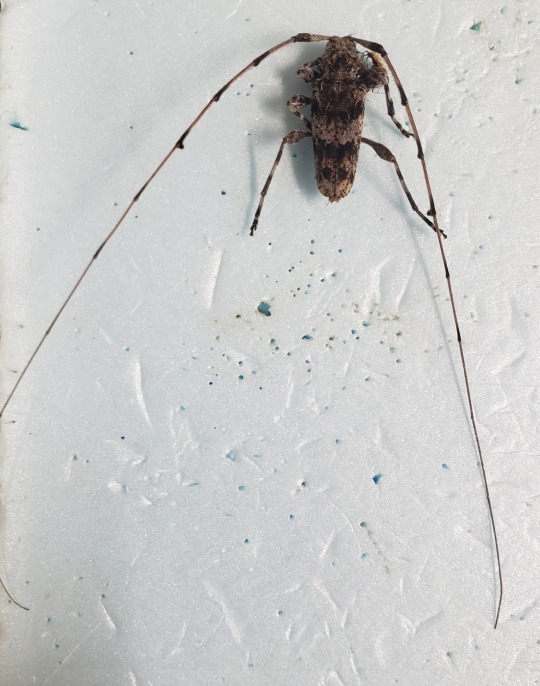

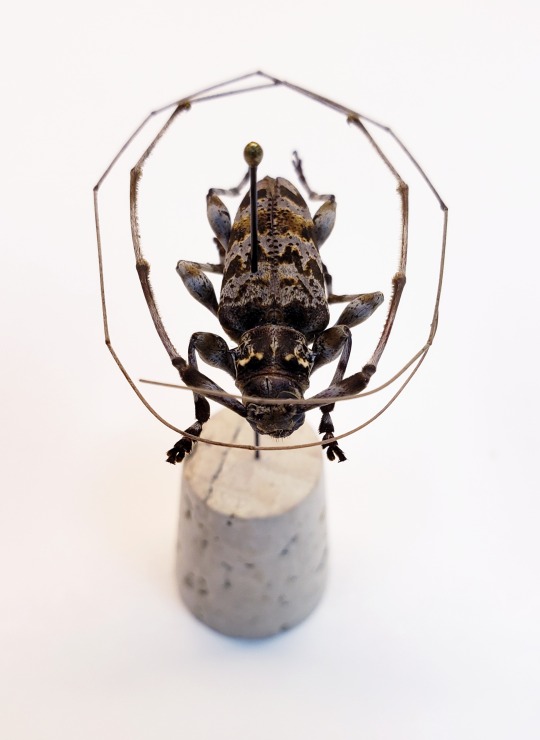

for insects that are too small to pin without risking obliterating their thorax, you'll want to point-mount them, which means gluing them to a small paper triangle and pinning that:


i rarely see people do it but you can sometimes curate point-mounted specimens too if they're the right size, though you'll want to do it under a microscope:
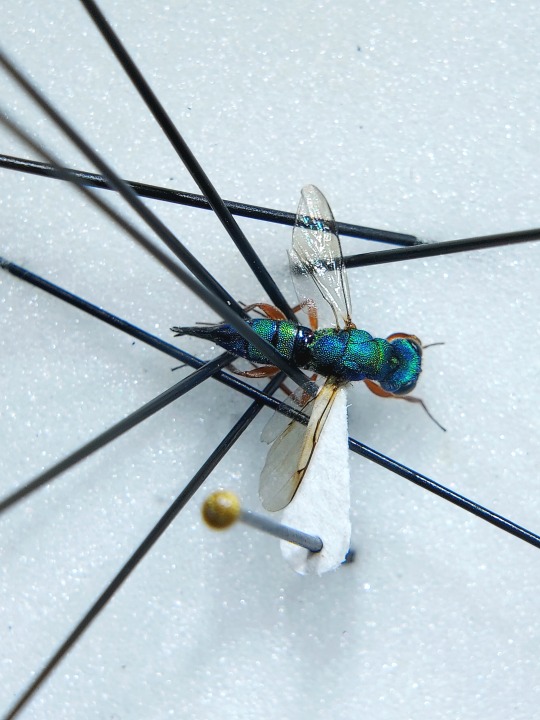
then let your specimens set in a nice dry area for at least a day or two:
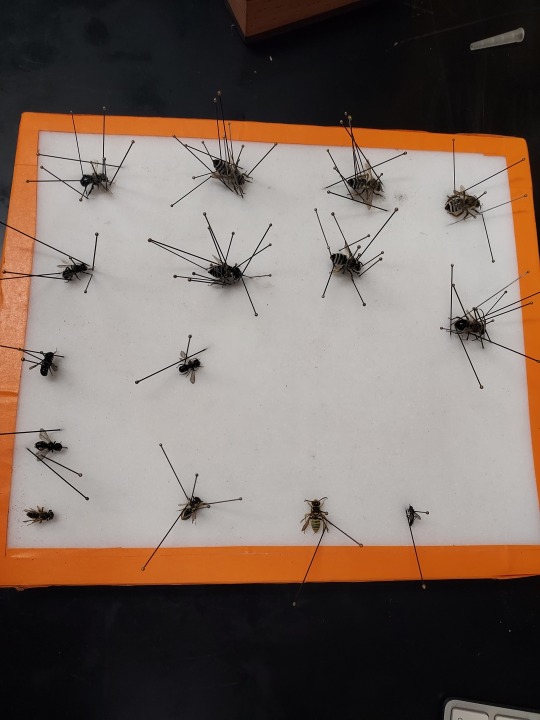

after that you just need to label them (probably for another post. this one is long enough) and they're good to go. once they dry out they're pretty much good to last forever as long as you keep them protected from mold and pests, so the preservation part is handled just by keeping them in an airtight container if possible or at least one with desiccants/pesticides as needed. at the very least try to toss the specimen box in a feezer for a few days at least a couple times a year. otherwise your nicely curated specimens will end up as dermestid shit:


i think that about covers it! it is worth noting that some soft-bodied insects will shrivel horrible when they dry out. small soft insects like silverfish, termites, springtails, most kinds of larvae, etc should go into a vial of alcohol rather than be pinned. same goes for most non-insect arthropods like spiders and centipedes and millipedes which will also fall apart when they dry. also some larger semi-soft insects will need to be stuffed to keep their abdomen from shriveling up, primarily larger grasshoppers, crickets, stenopelmatids, mantids, and stick insects. i made a post about how to do that here.
#insect curation#fuck i always forget if i have a tag for posts like this#i'll add it later if i remember#long post
211 notes
·
View notes
Text
I have already been using the website bug guide pretty much exclusively for my bug information because it uses a very standardized set of information that isn’t usually biased towards a region, and I know about the website macroinvertebrates as well but I’ve been warned it has less generalized information/photos and more Northern usa specific content than is applicable to my southern location, but does anybody know of any other really good online sources of aquatic insect based information?
I’d also appreciate literature recommendations. My usual go to book was the aquatic insects of North America book by Merritt et al, but l’ve kinda lost my access to it via graduating college. I can’t remember which edition i had access to. I’m trying to restore my reference abilities for identification and detailed info.
24 notes
·
View notes
Text
Walked in a bookstore today and saw a beautifully illustrated pocket guide to insect identification, and an even more beautifully illustrated book on flower symbolism. When I tell you the fic writer in me went insane-
#alas they were too expensive to consider asking my parents for them.#I do not have money of my own that isn’t on our country’s coin ://#wife speaks#not hilda#the thing about insect identification being linked to my fic writing only makes sense if you read one (1) specific story of mine#HDJDHKDDH sorry
24 notes
·
View notes
Text
actually the rspb website is a great resource for anyone that wants to mention british wildlife (in particular birds) in their fics and they're unsure of the variety of little funky birds we have over here.
have another link to the website.
the woodland trust is a wonderful resource for the various animals we have in the uk too. they cover various species of birds, mammals, reptiles and amphibians you can find (as well as my beloved insects). they also have a handy tree identification guide.
have a link to the woodland trust website.
#pfh talks about england#i'm not sponsored by or working for either of those organisations#i just think they might be a good resource for those that are curious#but in the spirit of honesty i am a member of the rspb for £5 a month because birds are lovely
15 notes
·
View notes
Note
hello! i was wondering if you have any tips or advice on id'ing/improving at id'ing bugs and the like? ive always really liked bugs and id love to get better at identifing them, but currently im pretty bad at it hshshs
There's not really any shortcut to getting better at it other than practice. I recommend taking photos of the bugs you find and trying to ID those for practice. Feel free to also submit them to me afterwards so I can confirm your ID!
In this post here, I talk about iNaturalist which is a very excellent resource for helping to ID.
Depending on where you live you can also try to find an insect or arachnid field guide to at least help you learn the common ones in your area, and a lot of times books like that will have an introduction in the beginning with basics on IDing.
45 notes
·
View notes
Text

Registration for Penn State’s annual WaspID course is now open! The course will be held over 2 weeks from January 15-26 2024 with the option for both synchronous and asynchronous virtual lectures.
The WaspID course includes:
Lectures and workshops by over 20 leading Hymenopterists from around the world (including me!) about wasp systematics, taxonomy, biodiversity, morphology, and biology; how to collect and rear wasps, insect preservation and curation, and identification and recognition of all 100+ extant wasp families (including 20 new families just discovered this year!)
Access to the brand-new 2nd Edition of the open-source textbook Biodiversity and Classification of Wasps (which I helped write)
Access to literature lists, identification guides, and 3D specimen images
An opportunity to network with hundreds of other wasp enthusiasts and researchers
The option for graded assignments and course certification for university credits
Click here to learn more about WaspID, and click here to register!
23 notes
·
View notes
Note
Where do you learn all these care specifics and scientific names and such? I've kept lots of critters (2 madagascar hissing roaches for a few years, some wild-caught adult grasshoppers and katydids for a few months, some mealworms into adulthood, etc) but I never knew stuff like what specific diseases they can catch and how to check, or how to tell different species of grasshoppers or whatever apart. Did you study this in college or just read up on things on your own? When I try to look up stuff like cockroach care I always end up with a million "how to kill nasty evil roaches because everyone hates them" articles.
I've been identifying bugs and using scientific names since I was little, so the years of experience helps, but there are many very accessible sources to help make learning about bugs easier!
I started with a field guide a lot like this, although some of the more basic ones don't have even half of the things you could find (just the more common ones). good field guides should also have scientific names, so you can learn those alongside the common names. scientific names are often much more helpful than the common names since those can change with region and language, but also because many bugs just don't have a common name.
if you happen to be in the US or Canada, BugGuide is a very useful resource where you can ask ID or look at other's submissions. obviously it's fairly limited by range, but has some very nice records and helpful experts.
iNaturalist is also a very helpful tool. it's fun to explore your local critters as well as those all around the world with the map, and you can get pretty decent IDs from the community (though often non-experts and the AI identifier can both be very wrong).
various forums and social media are also great for talking to other keepers and learning about bugs in captivity from them. as much as I hate it, Instagram has a nice population of bug keepers and just chatting with them can give you a lot of helpful tips and strategies.
79 notes
·
View notes
Note
Tips for identifying bugs? I do not live in america or am one
I've been busy but I'd like to put together a decent supplementary guide to TYPICAL arthropod body-shapes by phylogenetic group, to help people try to narrow down their searches regardless of where they are in the world.
However this might take me a while because I can't think of a good way to NOT need to make my own illustrations for it, and it's only half the battle anyways
You'll also need an insect and/or arachnid identification guide book for your region! Some guide books list noteable characteristics for phylogenetic groups, so you might not even need to wait on me to draw all that haha. I can't say I'm familiar enough to recommend any authors or publishers though, sorry.
There are probably also websites for identifying bugs outside of North America, but alas, I am nkt familiar with them so I cannot recommend any
20 notes
·
View notes
Text
vagueposting but i link to the post pissing me off and quote it. so not vagueposting at all but the blog has a massive following so it's not like. bullying
there is A Post i keep seeing, despite my best efforts to scrub OP from my dash, and it's specifically this version
reasons this post annoys the bejeebus out of me:
This is not a dunk on fandom—love the energy!—but I dream of the things we all could accomplish if we devoted some of that love and passion to the living creatures of planet Earth.
This is absolutely a dunk on fandom. You have literally structured your post around calling out "fandom" for not spending energy on something you think is more worthwhile. "Oh, no, OP meant in addition to fandom activities--" Nope! Maybe that's what they wanted to say, but they did not frame their post this way. The singled out fandom, played the "not to mean but--" card completely straight, and then somehow laid their environmental anxieties at the feet of fandom. They genuinely sound like one of those PTA moms who gives themselves anxiety over what innocuous things other people's kids do in their free time, which do not affect them at all.
[...]
Let me tell you a secret. Talk to gardeners and ecologists from your parents' and grandparents' generation, and you will recognize the same kind of people [as artists], passionate, socially awkward and probably some flavor of neurodivergent, except their blorbos are lichens, salamanders, mushrooms, bats, turtles, and birds.
These people were the ones that taught us how important those creatures were in the first place. That learned how to study them and wrote down what they observed.
Here's a neat little rhetorical device where OP isolates people "from your parents' and grandparents' generation" as separate but still accessible entities. This magical mood of loving nature is so close to you, but you've been isolated! Forgotten the old ways! These magic old people infused you with love for nature, and learned how to.... study them and write down what they saw...? No one was studying ecology or studiously improving gardening methods before your grandparents. There are no gen Z ecologists. There are no magic nature-loving people who also do fandom. Nuh-uh. It's just these magical older generation gardeners with all this secret knowledge.
Also, I never talk about (one part of) this, but I am a neurodivergent scientist running a fandom blog, and I do think claiming ecologists/gardeners are all "some flavor of neurodivergent" is a super weird take. First, ecologists (and scientists at large) are diverse people, not some cute stereotype in your head. Second, don't diagnose strangers, jfc. Third, "some flavor of neurodivergent" does not automatically make someone your friend or your magical relatable nature guide who wants to infodump all their cool nature facts like a trained dog.
IME ecologists and other people working in conservation ARE hype to tell you about their research and work, but I think linking this trend of enthusiasm to "oh, probably your local cute neurodivergent person--" is harmful in more ways than one to, like, everyone involved.
Here is something important: People cannot care about saving what they haven't even heard of.
This is true, or at least dogma I've heard actual conservationists say. It also has nothing to do with "fandom."
When I first started researching plants, I was shocked and horrified to find the internet almost empty of informative resources. No pictures, no paragraphs written by knowledgeable people, no cheat sheets, no diagrams.
There is not a single photo of a couple-months-old American Sycamore sapling anywhere on Google. Not one.
This is not true. There are in fact many plant identification websites, along with insect, spider, bird, mushroom, etc websites, often run by government organizations, botanical gardens, plant nurseries and nature enthusiasts. They often look like they were designed in the early 2000s and never updated, and there's not a really good umbrella website (except maybe iNaturalist?), but these resources definitely exist. If you google "Platanus occidentalis seedling" or "Platanus occidentalis sapling," you can indeed find the photos OP claims do not exist (examples: x, x). This is the piece of the post that pisses me off the most, because by claiming things literally don't exist on the internet, you actively discourage people form seeking them out.
Side note: I actually blocked OP over a different set of posts where they blogged at length and with extreme performative concern over not being able to find a specific type of study, which was a study design so common anyone who's spent more than thirty seconds figuring out google scholar could have found one. Posts like this are not actually helpful for general science education and instead just upset people while simultaneously misinforming them and discouraging them from doing their own searches.
When I started doing educational events at the place I volunteer, I had to write stat blocks and handouts about my trees MYSELF. From scratch.
So does the information literally not exist, or did you compile existing info into a streamlined form to fit your purposes....? How did you learn the information? Did one of the magical old people tell you?
Everyone I've talked to has said the same thing—I would like to plant native species and create a place for wildlife, but there isn't any information.
Don't let people tell you that you can't do anything. We already have scientists. We need artists. Bloggers. Enthusiasts. Hobbyists. Shitposters. We need love, passion, and obsession.
These things exist. These types of spaces exist in real life and all over the internet. Why are you writing like they are a dying breed? Reddit might have its problems, but there are tons of subreddits filled with enthusiastic people who will help you figure out a native plant garden. There is almost definitely at least one desperate conservation group who has this information available for your area (try googling your region and "native plant" - example: "bay area native plant" brings up the California Native Plant Society). You will have to spend some time reading, but I promise the information is there if you spend as long on google as you do making posts like this. You are harming these groups by writing as if they don't exist or are barely functioning due to lack of community support.
We need people whose talents are in editing, photoshopping, shitposting and meme-making, because the internet is where the conversations of the world happen, and we need to be talking about the living things of our planet that are in peril. Their beauty. Their importance. I'm completely dead fucking serious here.
I do agree with this point. Scientists are trained to make graphs, but they're not trained to make graphic design, if you know what I mean.
However, OP's goal is......
Do y'all have any idea how powerful a force your enthusiasm is?? To save the world, we need people who are like that, but about niche bees.
Imagine the most feral and unhinged of freaky fandom folk.
Now imagine someone who is Like That about prairie grasses.
To... have "fandom folk" redirect their energy at.... plants and bees? The subsequent blogging indicates that OP simply wants more blogs that post photos and art of plants and fungi. Okay, cool. What does this have to do with fandom? Do you know that fandom is a hobby for most people, and they go off and do other things in their life that might not be apparent to you, a stranger on the internet? Do you know how many of these magic ecologists and conservationists spend all day doing the work you want to see, and then go goof off in fandom to relax? Do you know that you do not have the right to control or criticize people's harmless hobbies, which do not affect you?
Someone else reblogged and added this comment:
Unfortunately fandom is mostly character analysis, and plants have no character to analyze so this will never happen
Also, the most helpful thing for them to do to save the planet is to donate money to those already doing it, not clogging up the system with terribly thought out newbie orgs
OP decided to reply to this comment more than once, jumping on the idea that "plants have no character" as ridiculous and then making fun of the idea of donating money. I want to emphasize that OP reblogged this person twice, which solicited their many followers to jump on their wording and yell about making plants blorbos, rather than think about any of OP's supposed points about conservation or gardening or environmentalism.
This person, apparently: the only form of doing good in the world that exists is donating money to a charitable organization. There is no such thing as work or outreach or education only money
In the ideal world, people would have dedicated jobs for the things described above. There are people who make a living off of doing scientific illustrations, and I would love for there to be more paid positions where artists and trained educators work with scientists on outreach. Established organizations do need volunteers, but they also need money so they can hire trained professionals to do the things OP is calling on fandom for.
Anyway, as a scientist and a fandom blog, here's this:
What you do with your spare time is up to you. If it's posting weird headcanons at 2 AM, whatever. You do you. You do not have to direct energy at saving the world or whatever.
If you're interested in ~touching grass~, I recommend googling for state/national parks in your area, as they're easy to identify and often put on cool events. You can also google for specific societies or hobbies, or places like botanical gardens and nurseries. Hobbyist mycologists are wild people, for example. These orgs often have volunteer days if you don't have a lot of time to commit.
Are you an artist, graphic designer, or illustrator? You may be surprised how many groups would love to have you design a pamphlet or logo! They will generally give your the information they want people to know and not just have you put together your own information unless you volunteer to do so (source: anecdata from scientists I know who also happen to be talented artists).
Memes are cool, but if you're trying to use them to ~spread information~, please do your best to fact check and then also provide citations. If you make a viral meme of bad information I will be forced to write a vent post about it. :P
39 notes
·
View notes
Photo


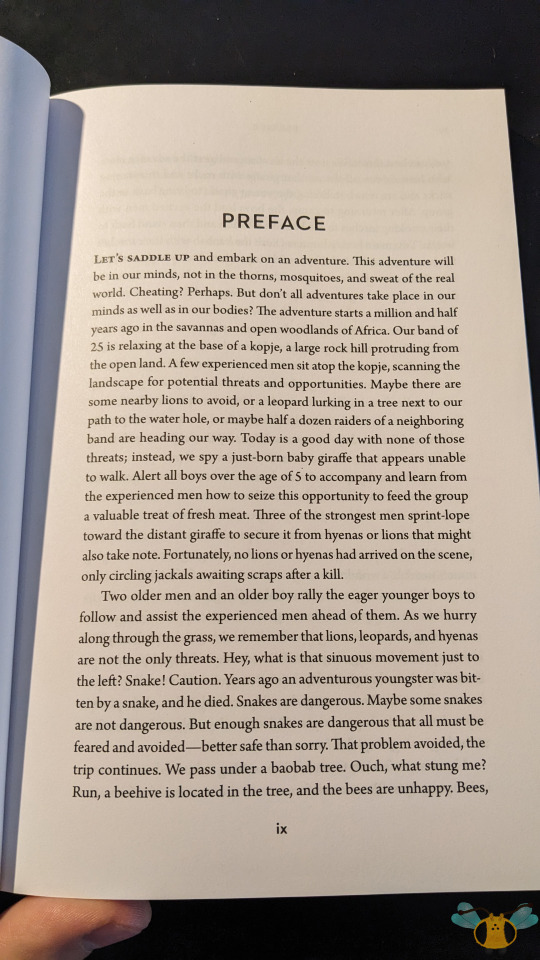
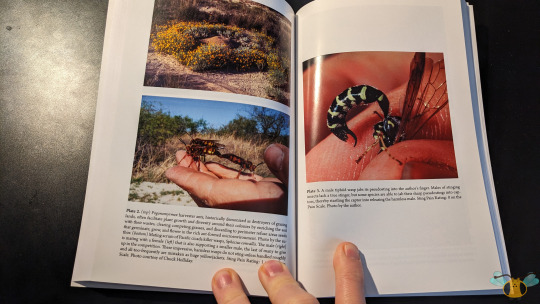
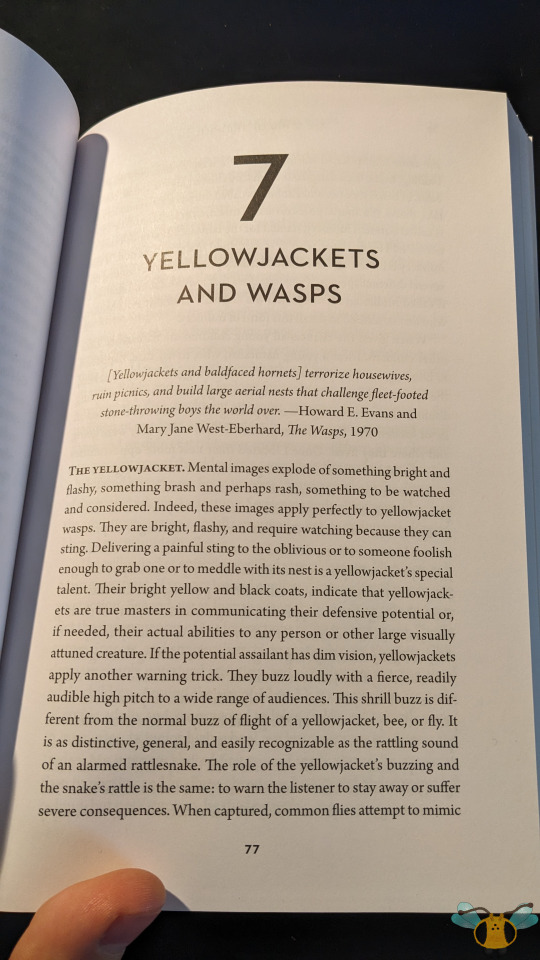

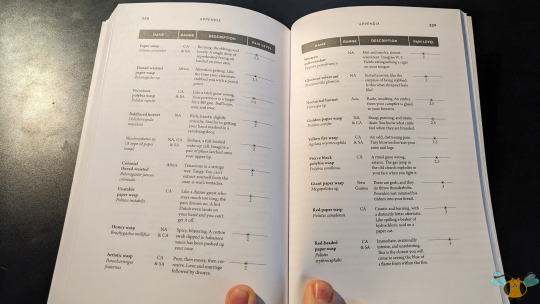
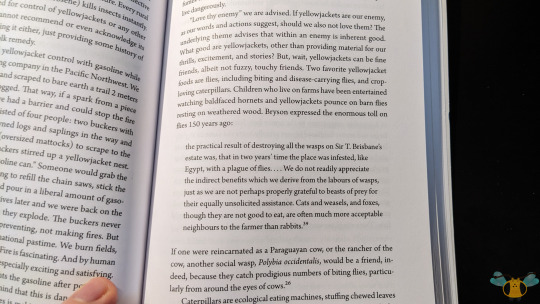

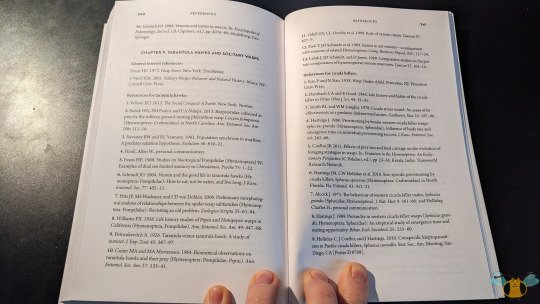
The Sting of the Wild, by Justin Orvel Schmidt
Let’s cut to the chase. I’ve thoroughly enjoyed this book and I believe it has something to offer for aspiring biologists, entomologists, insect hobbyists, researchers and people who have a great interest in the wonderful world of bugs! Due to the many mentions of pain throughout the book, the use of some technical language from biology research, alongside mentions of insects mating (ha ha ha), I would best recommend this book for a high school reading level or to those VERY interested in entomology. As well, there are funny (and cautionary) insect and nature exploration stories in the pages that would be quite suitable for children. Various excursions around the world and investigations into Ant digs or poking around Nests come to mind. Though serious in the moment, Schmidt tells his stories with a good dose of silliness to lighten the tone. He does not dwell in the moment of pain, instead championing the knowledge to be gleamed from it and how the experience led to happy moments to look back on. And he did live through them all after all. As such, the stories with may spark newfound interest in wilderness exploration to learn about the little creatures of the earth or serve as a guide on which insects should be kept away from small hands, such as the Velvet Ants, which are in fact wingless Wasps. The fuzz may be attractive, but that’s a warning advertisement, indicating that the stinger is primed! Anyways, while I’ll largely be keeping the contents under wraps so you can experience this book for yourself, here’s what this book has to offer.
The Sting of the Wild offers great insight into the mind of Justin Schmidt and his fascination with insects. It dives into his childhood adventures, his academic journey and his excursions in the field to document insects within the order Hymenoptera. He weaves these tales and journeys while exploring the history, intricacies, evolution and biodiversity within insects that are equipped with a stinger. There is thoughtful examination of the differences between social insects and solitary insects (especially how their behavior drives and forges them) and discussions of the perceptions different cultures have towards their stinging insects; e.g. Bulldog Ants of Australia aren’t as strong as they seem, meanwhile Bullet Ant stings are painful but are used in adulthood rituals in some nations! Furthermore, he dispels many myths about these insects, not labelling them as vicious, rambunctious aggressors, but rather as animals to be respected and treat as friends given their ecological significance and also the benefits they can provide humanity. For example: while we are inclined to think of Honeybees as gentle, vegan gatherers, they can be both monstrous and resourceful when it comes to protection of their hive and stores of honey (as can be read in Chapter 11).
Intermission: For additional insect literature, you may visit the Blog Resources page.
For cohesive examples of how best to consider the scope, tone and lessons from this book, please refer to Pictures 8 and 9. He does not castigate Wasps are our enemies, but also offers practical advice should you ignore their warnings and meet their sting. A bit tongue in cheek at times, but it gave me a good chuckle. If you desire a real hoot, refer to the pain index at the back of the book with all the descriptions of pain sensations felt as a result of Schmidt’s adventures. Yes, this is the man who created the Schmidt Pain Index that attempts to quantify pain levels from insect stings! Consider those descriptions before you go bug-hunting for Wasps and decide to try handling them (unless you are sure they are male). To conclude: it’s worth noting that this book doesn’t offer much in terms of insect identification beyond a few specimens and several pictures from the field. However, the quality of research in this book is superb, all listed in the index with sources readily available for further reading. And finally, and to be as clear as possible, this book is not a fully memoir or autobiography. While parts of his life are covered and reflected on, it’s the insects that make up the chapters of the book. The insects of the Sting of the Wild are put on full display, interpreted though the eyes, experiences and research of a daring man who took a hands on approach to these little creatures.
It must have been an amazing time to travel all over the world searching for insects, and I must speak in past tense as Justin Schmidt is no longer with us, having passed this year in February 2023 at 75 years old. His passing is actually how I found this book, and it was all the more ironic (but coincidental) that I shared a Paper Wasp post shortly after. While the insects were enough to draw my interest, it was Schmidt’s adventures, humor, passion and insights into entomology and stinger/ovipositor evolution that held my attention. Thank you Justin Schmidt! This post is for you. Thank you for a great read that I will revisit when I can. I’d also like to dedicate this post to my grandfather who also passed away earlier this week at the age of 89. He was a gentleman of patience, wisdom, care and intellect. He passed on a lot of knowledge to me and encouraged me to consider the bigger picture whenever he could and to be mindful. I miss him very much already. May both these men’s lives be celebrated fondly and eternally into the next just as the social insects within Hymenoptera build great cities and societies year upon year, regardless of the obstacles in their way. Peace and joy forever more, to the next world. You will both be remembered dearly.
#jonny’s insect catalogue#insect field guide#justin schmidt#the sting of the wild#justin schmidt the sting of the wild#insect sting guide#sting of the wild#insect pictures#insect facts#insect identification#field guide#entomology#arthropods
3 notes
·
View notes
Text
⚠️(I talk about insects below, so here’s a heads-up just in case; there are drawings of bugs as well)
I was wondering how Sticks could get infected by computer viruses once the computer was infected. Viruses or worms infect programs, and since I think a lot of Sticks are created by humans, they count as programs. Though even if some Sticks are born and not created, they’re still made of data and can get infected.
After the viruses/worms infect a computer through e-mail or various other ways, they change form and are even more sneaky. Basically they look like bugs (for the viruses) or animals like earthworms (for the worms).
Some examples:


Sticks can get stung or bitten by viruses pretending to be actual insects, arachnids or worms. A lot of Sticks who get sick are gardeners or entomologists. Unlike earthworms, the disguised worms do bite.
If the bug or worm isn’t very strong and it bites or stings a Stick with antivirus protection, it’ll get destroyed instantly and the Stick won’t have a chance to get infected.
I’m still working on it but that’s the gist of it for now.
References for drawings:
March fly (lovebug) - University of Wisconsin-Milwaukee article
Bumblebee - Friends of the Earth bee identification guide (UK website)
Earthworm - National Geographic article
17 notes
·
View notes
Text




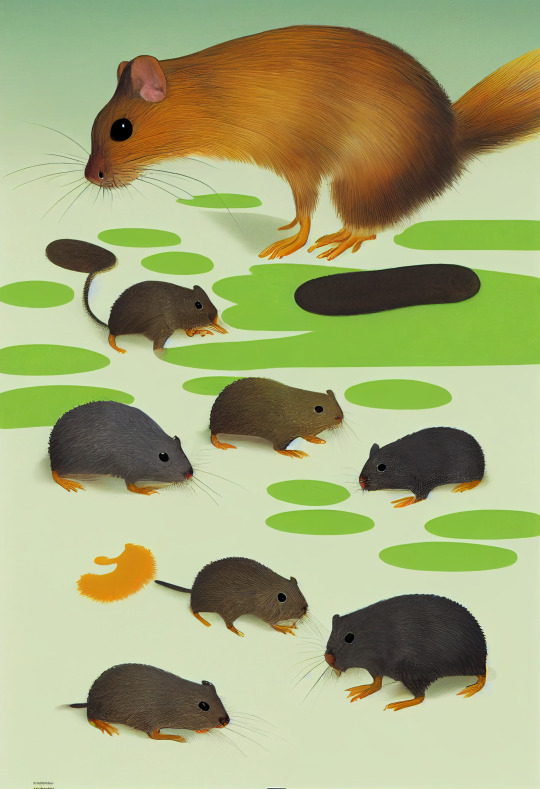

Know Your Voles
Burrowing fuzz-bearing critters may seem creepy, but did you know voles are an important part of the ecosystem? Yes, even if they dig up a few of your tubers every spring! Here''s some fun facts about our tiny roommates!
Every garden cittervole eats thousands of insects and arachnids per moon, including mites and tuber-beetles that are dangerous pests!
Most Voles don't lay eggs, and instead give live birth! This does not mean they are closely related to snakes, however. That's just an old wives' tale!
Voles are social creatures that raise their young, just like we do! Vole mothers even feed their young with a special sweat they produce from patches on the belly
Voles are not downy! The fuzzy covering that keeps them warm is called 'fur' and, while structurally similar to down, it is a more primitive and less differentiated structure.
Vole jaws can move side-to-side, an ability they use to "chew" through solid wood to make burrows in tree stumps or, yes, your house. Some voles can even bite through metal given sufficient time and inclination.
Despite this, you can keep voles out of your home with a spritz of diluted longberry oil. Voles are sensitive to the flavor-compound capsaicin and avoid it.
For more information about voles and how to handle them ethically, contact your local office of Civilian Logistics, Administration and Welfare for our informative pamphlet packed with scientific facts, handy tips and tricks, recipes, and a field identification guide.
#midjourney v4#midjourney art#worldbuilding#alternate universe#vole#voles#it is a rough translation#science fiction
25 notes
·
View notes
Text
pest control blog

How To Get Rid of Rats in Drains: Expert Tips & Solutions
Identifying Mouse Droppings: Potential Hazards and How to Clean Up Safely
Rat Droppings: The Hazards of Inhaling or Touching Rat Faeces
Expert Advice on How To Get Rid of Rats From Home and Garden
Pigeon Lifespan: How long do pigeons live?
How Do Flea Bombs Work? The Pros and Cons of Flea Bombing
How Long Do Flies Live?
Do Mice Hibernate?
Field Mice: How to Identify and Control
Bed Bugs: How to Identify, Control, and Treat
Understanding the Bed Bug Cycle and How to Kill Bed Bugs
Where Do Bed Bugs Come From And How Do You Get Bed Bugs?
The History of Bed Bugs
Locate and Destroy the Bugs: Bed Bugs
Heat Treating for Bed Bugs: Pros and Cons
How to Identify Bed Bug Bites and Recognise the Signs
Bites in the Bed: Identifying Bed Bug Bites
Treatment of Bed Bugs – Effective Solutions
How to Get Rid of Bed Bug Bites Overnight
How to Effectively Treat Bed Bugs: DIY and Professional Solutions
Uncovering the Mysteries of Bed Bugs: From Diagnosis to Prevention
Pest Advice For Controlling Rats
Common Mouse Species Found in The UK
Mouse Control: What are the Best Mouse Exterminators and Repellents?
Mouse Identification Chart to Quickly Identify UK Mouse Species
How to Get Rid of Mice: The Benefits of Different Mouse Traps, Repellents, and Baits
Identifying Fox Den Locations in the Garden to Keep the Foxes Away
Types of Earwigs and Their Habitats
Identifying Different Types of Crab Spiders
Identifying Fly Eggs: How to Spot an Infestation
How to Identify House Crickets Infestation and Take Action to Stop Them
A Guide to Identifying Big Spiders in The UK
How to Tell If You Have a Roach Infestation and When to Hire an Exterminator
Choosing the Right Pest Control Services: Tips and Advice for Homeowners
Debunking Common Myths About Spider Bites in the UK
Flea Spray For Home: Professional Tips for Controlling Fleas
The Best Tips for Setting Up a Humane Mouse Trap in Your Home
Baby Pigeon: How To Humanely Remove Baby Pigeons From Your Home
Effective Ways to Deal with an Ant Infestation in Home and Business
Rat In Garden In Daylight: Tips for Making Your Garden Rat-Proof
How to Get Rid of a Wasp Nest: A Guide to Safe and Effective Wasp Control
The Most Effective Treatment of Bed Bugs: What You Need to Know
Types Of Fly – What Are the Different Types of Flies In The UK?
Small Tiny Brown Bugs In House UK
How To Get Rid Of Ants In Kitchen
What Do Bed Bugs Look Like?
The Dangers of Pests: How to Protect Yourself from the Health Hazards They Bring
Don’t Take Pests Lightly – A Comprehensive Look at the Health Dangers They Pose
The Hidden Health Risks of Pest Infestations: The Link Between Disease and Rodents, Insects, and Other Pests
How To Get Rid Of a Mouse?
What is the best way to get rid of rats at home?
How to deal with rat in garden in daylight
Who Is Responsible For Rats In a Rented Property
Wood Worm Control
Pigeon Pest Control Near Me
Pest Control Harrow
Tower Hamlets Pest Control
Seagull Nest Removal Near Me
Cluster Fly Killer
Best Way To Get Rid Of Mice
Flea Exterminator
Wolf Spider UK: Bon Accord Pest Control, Wolf Spider Control Experts
Garden Spider UK
House Spider UK – Control and Removal
Wasp Nest Removal Near Me
Wasp Exterminator
Biscuit Beetle Control
Carpet Beetle Spray
Bon Accord Best Ant Killer UK – How to Deal with Ant Infestation
Spray For Bugs
Pest Control Supermarket
Spray for Bed Bugs
Wasp Removal
Say Goodbye to Pests with Bon Accord – London’s Best Pest Control
Bed Bug Killer
London Pest Control Near Me
Mouse Deterrent
Do Mice Usually Go Upstairs
Rat Repellent
Rat Killer
Cockroach Killer London: Bon Accord Professional Extermination Services
Bird Netting Services
Bed Bug Spray
Moth Killer
Spray For Bugs in Bed
Fly Killer
Bon Accord Ant Killer -We Deal with Ant Infestations
How Common are Bed Bugs in London Hotels
Rats In Garden – Find Out How To Get Rid Of Them
What Do Ants Eat?
Best Rat Poison In The UK
Bed Bug On Mattress – How To Get Rid Of Them
Fox Deterrent And Repellents That Actually Work
How To Eradicate Bed Bugs In The Home – Bed Bug Removal
6 Signs You Have a Bed Bug Infestation – Bed Bug Exterminator Advice
Why Hiring a Professional Exterminator is the Best Way to Treat Bed Bugs
8 Bed Bugs Treatment Options
How to Avoid Bringing Bed Bugs Home from a Hotel – Bed Bugs Killers
How to Get Rid of Ants and Keep Ants Out of Your Home
5 notes
·
View notes
Text
Columbia livia
[Disclaimer: I am a dumb highschool kid who likes plants and nature. I am by no means a professional or an expert in any field. Don’t take anything I say in this or any other post as fact. This is to be taken as the autistic infodumping that it is. I am open to being corrected.]

[Image one: bird feather.]
I often see feathers like this one here on the ground at my local arena.
Throughout my life, I’ve often wondered what they were. I posted one of these to iNaturalist a while back.
Someone suggested it to be a feral rock pigeon, also known as a rock dove. I always take anything Seek or iNaturalist tells me with a grain of salt. The former is a computer, computers require training and it’s not realistic for a computer to be perfectly trained in all the detail that the natural world provides; the latter is a person, and all humans have the capacity to be wrong.
This one made sense, though. Especially after looking into the species. The birds that fly over my head while I ride look just like the ones in the book.
Also, I’ve decided to start citing my sources.
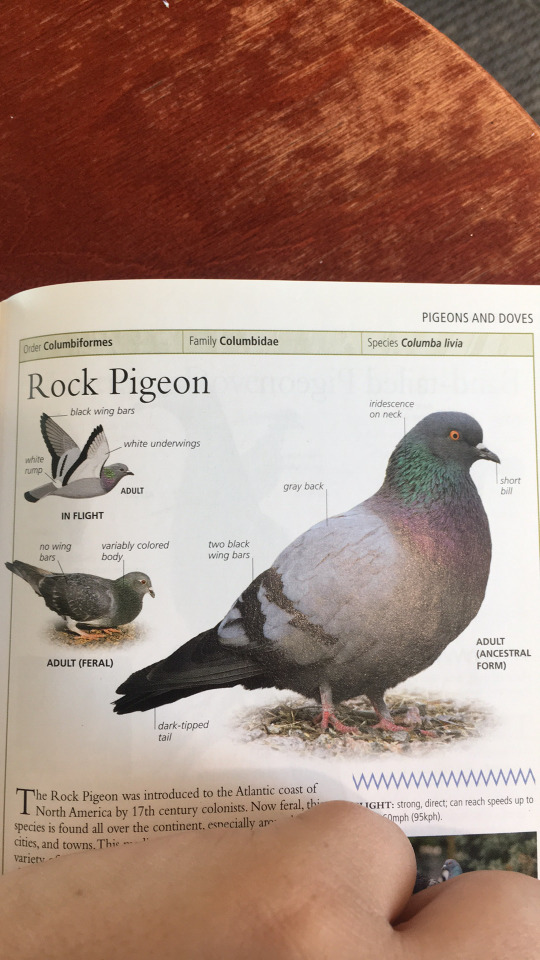
[Image two: columbia livia as pictured in ‘Birds of North America: Western Region’ by François Vuilleumier]
Unfortunately, my local library is incredibly lacking in the Natural Sciences department (or any nonfiction department in general) so I couldn’t find many paper sources.
I’m considering starting a fund to help fix that-.
Now the part you’ve all been waiting for, me brainrotting about a bird species.
The Columbia livia, the most common member of its family within the United States.
This species was introduced by colonists as a domestic species, though wild variants do exist in Africa and parts of Europe. In North America, however, they are an entirely feral species.
This species can be found over the entirety of the US and Mexico as well as southern parts of Canada, they are more common in cities and other populated areas.
Their diet consists of mostly seeds and fruit, and (of course) human food. Despite this, they weigh less than a pound, around 14 pounds on the heavier end of the average. They are not picky eaters and will occasionally go for insects (honestly surprised me that they were not a staple of a pigeon diet)
They mate year round and produce several batches of offspring a year, though they only produce two eggs per batch. They prefer to nest on flat surfaces like the top of buildings or in caves.
They are larger than most doves (as they are pigeons and should be called as such, I will die on this hill) and as a family trait they have their nostrils positioned on a fleshy mound at the top of their short beaks. They are most commonly found in various shades of grey though they do come in other colours.
Also they fly at least 60 mph, which is faster than a horse can run.
Good god, it’s getting late. I have to run back to the arena before I’m late, but here’s a list of sources I found in the library before I leave.
I’ll edit in cover images later, the wifi is being weird here.

[Image three: source book one; ‘Birds of North America: Western Region’ François Vuilleumier]
This one was probably my most handy resource in all of this, it was very information dense.
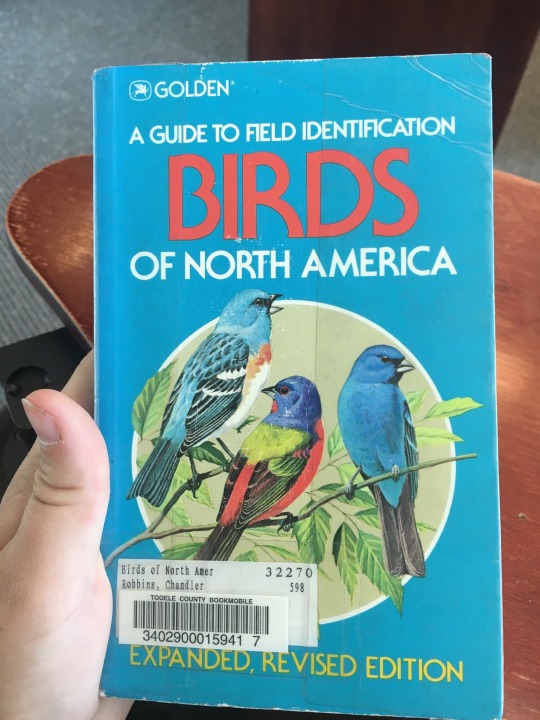
[Image four; ‘A Field to Guide Identification: Birds of North America’ by Chandler Robbins]
This one was mostly used to fluff out the information I already knew, as it had a section on this species but not nearly as large.
Thanks for reading! I’ll be back soon with more species to talk about from the Nevada border area. Until then, be safe.
-Nicholas Engelmann
#nature#birds#backyard birds#naturalist#inaturalist#Columbia livia#rock pigeon#rock dove#Nicholas Engelmann#Nicholas Engelmann - rants
2 notes
·
View notes